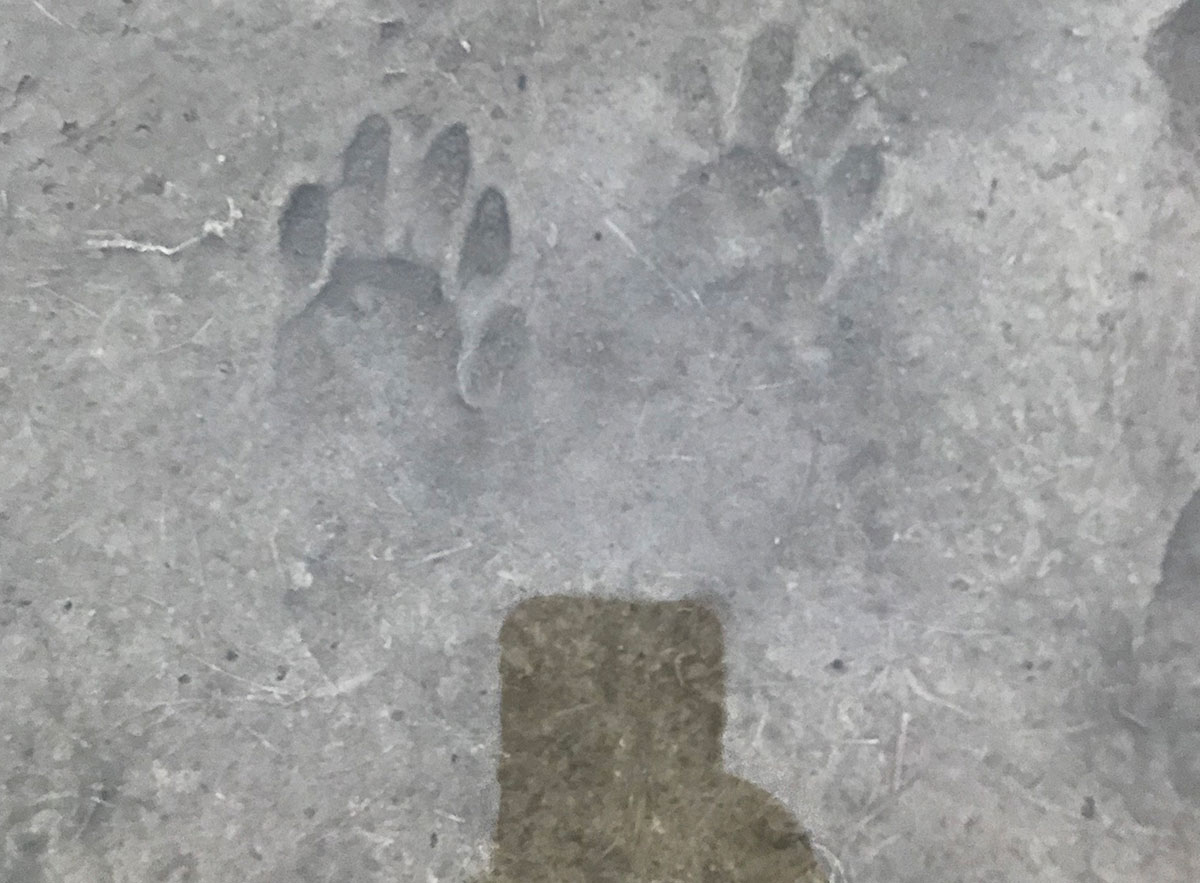Photo: A pair of mystery footprints in shallow water on the margins of a pond on a South Texas ranch. At the bottom is the shadow of the author’s I-phone for scale.
The first week of March this year I got a message from our nephew Darin Rokyta, an Associate Professor of the Department of Biological Science at Florida State University where he studies venoms. He was going to be in Kingsville, Texas at a conference the next week with three grad students and three undergrads and wanted to know if I knew of a ranch nearby where they could collect snakes and scorpions.
I thought a bit and couldn’t come up with a rancher I knew closer than Freer, Texas. But, our Congressman Filemon Vela has a district coincidentally shaped like a snake that goes for almost 300 miles from Brownsville to Gonzales, passing near Kingsville. Surely, he’d know of a ranch in that area. So, I sent Congressman Vela a message entitled, “a strange request.” Within minutes he responded, tasking his staff to find an appropriate snake and scorpion venue for Darin. Before twenty-four hours expired, his staff found a ranch owned by Sam Manatt, III who graciously offered his ranch east of Harlingen and Rio Hondo.
Darin and crew planned to camp in East Texas’ Sam Houston National Forest on Monday, March 12th, and would be leaving the next morning for Sam’s ranch. I decided to meet them at the ranch on Tuesday afternoon on the 13th. That morning I mapped the route on my I-phone, which said if I left at 10:00 am I’d arrive at 1:30 pm. That was perfect since Darin planned to arrive about that time. After gas, coffee, and meal stops from Harlingen, where I turned east, my I-phone said I would arrive around 2:00 pm. Unfortunately, the mapping program didn’t know a bridge was out between Harlingen and Rio Hondo. Furthermore, it kept insisting I should cross that very bridge. After following its directions twice just to make large circles and end up back at the bridge, I ignored it and followed the detour signs. That got me around the bridge.
Arriving where the mapping program told me to turn at about 2:30 pm, I found nothing there. As I passed the non-existent turn, the mapping program changed its mind and sent me further east. I complied with its instructions. In a few miles it said turn south; I did so. Then it said turn west on a small paved road. I did that. Then it had me turn north on a dirt road, which ultimately hit the original road the ranch was supposed to be on. There the program told me to turn left back to west. When I got back to where it said to turn to the ranch, about 2:45 pm, I gave up and called Sam. Following human directions, within a few minutes I arrived at his ranch house. If robots ever take over, surely it will be by giving us humans bad directions…
In the meantime, Darin and crew had experienced a few delays of their own. By phone I advised Darin of the tricks he’d need to know to cover the final path from Harlingen to the ranch. While awaiting them, Sam and I visited across a coffee table housing the large skull of a Cape Buffalo (you should ask him how he came to own the skull), discovering we knew some of the same people. Darin and students finally arrived around 5:00 pm.
Sam gave us a guided tour of the ranch and the Darin’s students turned over logs and kicked through grass and cactus to find lots of scorpions of various types. Near evening one of the grad students made the find of the trip, a Black Stripe Snake (Coniophanes imperialis), which is found only in the southern tip of Texas. Darin told me he needed that snake to complete a venom series on the species. Then, just after dark, everyone gathered around to see a demonstration of tubing and sedating a male five-foot Western Diamondback Rattlesnake (Crotalus atrox). Sam wanted to see this procedure, so he could replicate the feat. Why would Sam want to do this? It’s part of training his dog Mona, a black Lab, to avoid rattlesnakes. He would let Mona, wearing a shock collar, approach the sedated snake and when she got sufficiently close he’d deliver a shock. The theory being that after a few training sessions, Mona would actively avoid rattlesnakes without having been bitten.
At the end of the demonstration, which proceeded without any accidents, I had to leave, it being 9:00 pm. Darin and students remained at the ranch to search for more scorpions using black light flashlights. Scorpions fluoresce under UV light and are easy to see after dark.
All-in-all, it was a productive trip for Darin and his group and I thoroughly enjoyed the visit. Also, one of the stops on our trip around the ranch was a pond. I saw at least two species of fish but could identify neither. My fishy friends will be shocked to discover that I’d failed to bring fish collecting equipment. I suppose a future trip to the ranch in is the cards to see what those fish might be. At the pond we also found a pair of tracks that none of us could identify. I later sent a photo of the tracks to a couple of animal track expert friends who thought they only could match those of a Ringtail (Bassariscus astutus). But, Ringtails are small, cat-sized animals and the prints were way too large. For scale, note the shadow of my I-phone below the prints. I’m going with a Chupacabra (see my blog on chupacabras) until a better identification is made.
May all your days be as interesting.


Paul Kotarides says
Perhaps they are coatimundi tracks?